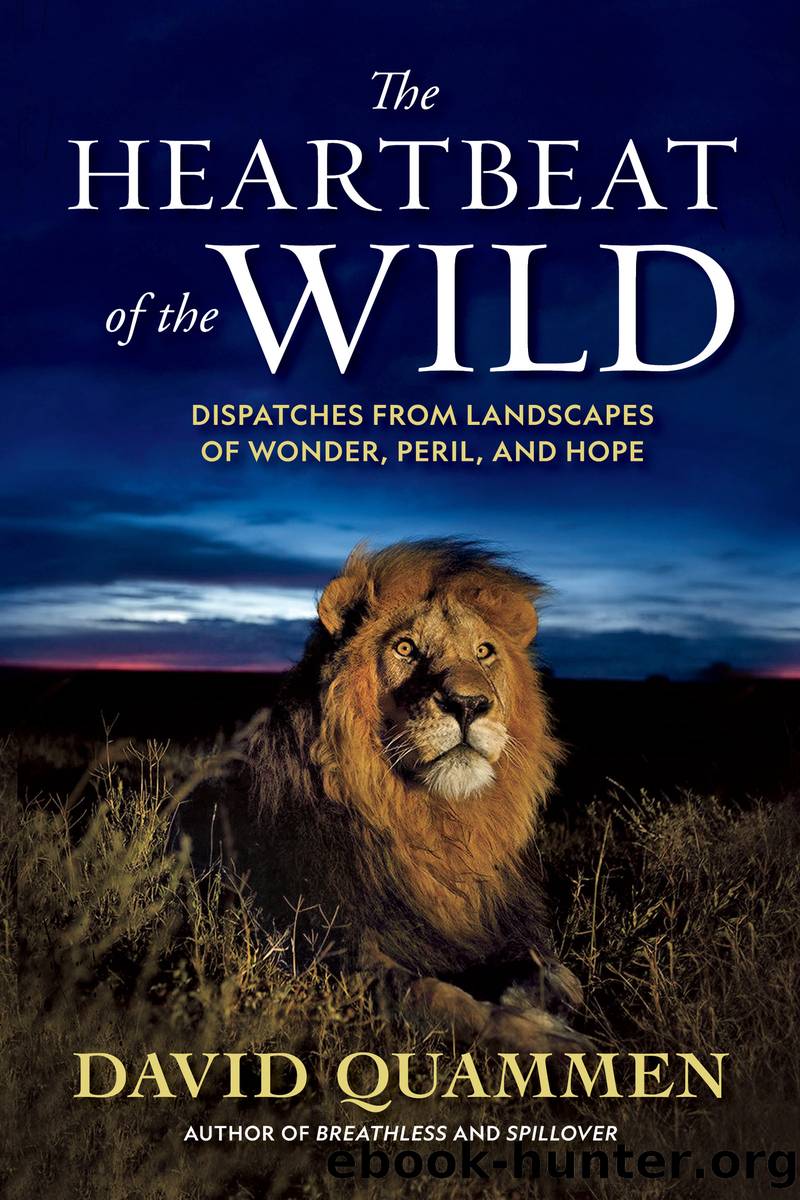The Heartbeat of the Wild by David Quammen

Author:David Quammen [Quanmmen, David]
Language: eng
Format: epub
Publisher: Disney Book Group
Published: 2023-04-19T00:00:00+00:00
The factors that menaced bonobos most severely in 2013, when this piece first appeared, continue to menace bonobos today: illegal hunting for bush meat and the destruction and degradation of their habitat. What drives those factors are population growth, poverty on rural landscapes, and hunger; what exacerbates them are corruption within institutions and profiteering by opportunists in the middle. Poor people continue to suffer, in the areas of interface between village and forest, and wild animals do too. The DRC now contains about 95 million humans andâa narrowed range, as estimate methods have improvedâprobably between 10,000 and 20,000 bonobos. Whatever the actual number, somewhere within that range or just outside, the safe assumption is that they are fewer than they were a decade ago. And this little-known, little-protected creature, confined to an area beneath the great northern bend of the Congo River, stretching southward to the Sankuru and eastward to the Lualaba, is one of humanityâs two closest living relatives.
There is some good news. On July 7, 2016, the government of DRC designated a sizable portion (almost 900,000 hectares, or 3,500 square miles) of the TL2 conservation area, at that easternmost edge of bonobo distribution, to be Lomami National Park. It became the countryâs first new national park since 1970, and if management, antipoaching enforcement, and socioeconomic relations with the people (Lengola, Mbole, and five other ethnic groups) of the surrounding buffer zone are good (see âPeopleâs Park,â pages 275â294, for a paradigm of how that might be done), then Lomami National Park will help protect not just its bonobos and other endangered and vulnerable species such as okapi, forest elephant, and Congo peafowl, but also populations of 12 other primate species. How many places on Earthâhow many contiguous areas of similar sizeâharbor 13 species of nonhuman primate? The answer has got to be âfew, if any,â and you would need a biogeographic map of Brazil even to begin addressing the question. The 13 in Lomami National Park include the lesula (Cercopithecus lomamiensis), a species of guenon unknown to science until 2007, when a team led by John and Terese Hart (in conjunction with the Lukuru Foundation) recognized its uniqueness during a reconnaissance trip by dugout canoe up the Lomami River. As for the bonobos, their range extends beyond the Lomami, almost to the left bank of the Lualaba. Down there near the Congo headwaters, as elsewhere, they are the left bank ape.
Cross the Lualaba, headed east toward Africaâs Great Rift Valley, and you reenter a relatively impoverished world: one without bonobos.
Download
This site does not store any files on its server. We only index and link to content provided by other sites. Please contact the content providers to delete copyright contents if any and email us, we'll remove relevant links or contents immediately.
The Lonely City by Olivia Laing(4751)
Animal Frequency by Melissa Alvarez(4395)
All Creatures Great and Small by James Herriot(4233)
Walking by Henry David Thoreau(3896)
Exit West by Mohsin Hamid(3778)
Origin Story: A Big History of Everything by David Christian(3651)
COSMOS by Carl Sagan(3559)
How to Read Water: Clues and Patterns from Puddles to the Sea (Natural Navigation) by Tristan Gooley(3409)
Hedgerow by John Wright(3280)
The Inner Life of Animals by Peter Wohlleben(3261)
How to Read Nature by Tristan Gooley(3250)
How to Do Nothing by Jenny Odell(3235)
Project Animal Farm: An Accidental Journey into the Secret World of Farming and the Truth About Our Food by Sonia Faruqi(3178)
Origin Story by David Christian(3149)
Water by Ian Miller(3129)
A Forest Journey by John Perlin(3027)
The Plant Messiah by Carlos Magdalena(2883)
A Wilder Time by William E. Glassley(2818)
Forests: A Very Short Introduction by Jaboury Ghazoul(2791)
